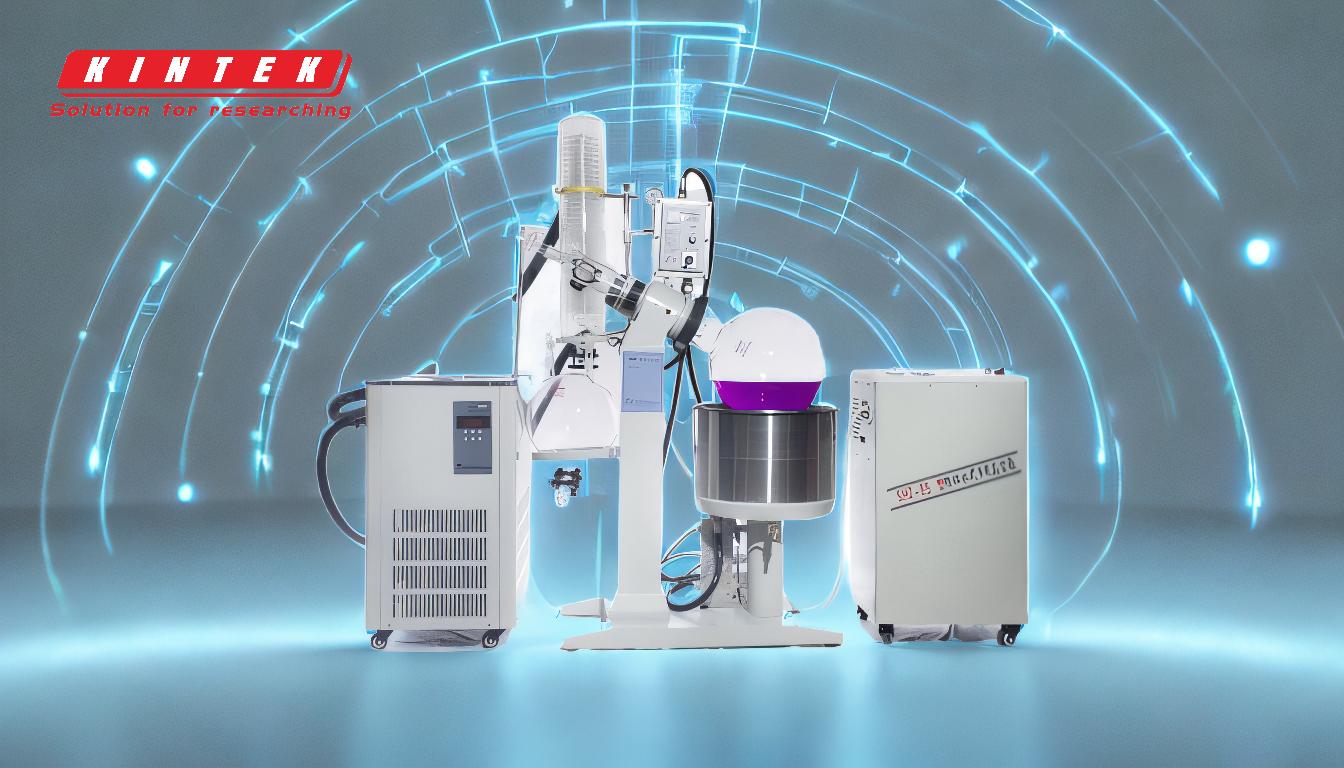A rotary evaporator, or rotovap, is a laboratory device designed to remove solvents from samples through evaporation. It operates under vacuum conditions, which lowers the boiling point of the solvent, allowing it to evaporate at a lower temperature than its standard boiling point. This process minimizes the risk of thermal decomposition of the sample and ensures efficient solvent removal. The rotovap is widely used in various fields, including natural, inorganic, and polymeric material research, due to its ability to handle sensitive compounds and provide precise control over the evaporation process.
Key Points Explained:

-
Purpose of a Rotovap:
- A rotovap is primarily used to remove solvents from chemical mixtures. This is essential in processes where the solvent needs to be separated from the desired compound without causing thermal degradation.
- It is particularly useful for samples that are sensitive to heat, as it allows for solvent removal at lower temperatures.
-
Principle of Operation:
- The rotovap operates under reduced pressure (vacuum), which lowers the boiling point of the solvent. This means the solvent can evaporate at a much lower temperature than it would at atmospheric pressure.
- The sample is placed in a rotating flask, which is submerged in a heated water bath. The rotation increases the surface area of the sample, promoting even heating and faster evaporation.
- The evaporated solvent is then condensed using a cold finger or condenser and collected in a separate flask for reuse or disposal.
-
Key Components:
- Rotating Flask: Holds the sample and rotates to increase the surface area for efficient evaporation.
- Heated Water Bath: Provides controlled heating to the sample, ensuring uniform temperature distribution.
- Vacuum System: Reduces the pressure inside the system, lowering the boiling point of the solvent.
- Condenser: Cools the evaporated solvent, converting it back into a liquid for collection.
- Collection Flask: Stores the condensed solvent after it has been separated from the sample.
-
Applications:
- Natural Products: Used in the extraction of essential oils, flavors, and fragrances from plant materials.
- Inorganic Chemistry: Helps in the purification of inorganic compounds by removing solvents.
- Polymer Science: Assists in the removal of solvents from polymer solutions, which is crucial for polymer synthesis and processing.
- Pharmaceuticals: Plays a vital role in drug development by enabling the separation of solvents from active pharmaceutical ingredients (APIs).
-
Advantages:
- Efficiency: The rotovap allows for rapid solvent removal due to the increased surface area and reduced pressure.
- Precision: It provides precise control over the evaporation process, minimizing the risk of overheating or thermal decomposition.
- Versatility: Suitable for a wide range of solvents and compounds, making it a versatile tool in various laboratory settings.
- Scalability: Can be used for small-scale laboratory experiments as well as larger industrial applications.
-
Considerations for Use:
- Solvent Boiling Point: The solvent to be removed should have a lower boiling point than the compound of interest. This ensures that only the solvent evaporates, leaving the desired compound behind.
- Azeotropes: Care must be taken to avoid solvents that form azeotropes with the compound, as this can complicate the separation process.
- Sample Sensitivity: The rotovap is ideal for heat-sensitive samples, but the temperature and vacuum settings must be carefully controlled to prevent degradation.
-
Comparison to Distillation:
- While both rotovap and distillation aim to separate components based on boiling points, the rotovap offers several advantages:
- Lower Temperatures: Operates at lower temperatures due to the vacuum, reducing the risk of thermal damage.
- Faster Processing: The rotating flask and increased surface area lead to quicker evaporation.
- Better Control: Provides more precise control over the evaporation process, making it suitable for sensitive materials.
- While both rotovap and distillation aim to separate components based on boiling points, the rotovap offers several advantages:
In summary, a rotovap is an essential tool in laboratories for the efficient and gentle removal of solvents from various types of samples. Its ability to operate under vacuum conditions, combined with precise temperature control, makes it ideal for handling sensitive compounds and ensuring high-quality results in solvent separation processes.
Summary Table:
| Aspect | Details |
|---|---|
| Purpose | Removes solvents from chemical mixtures, ideal for heat-sensitive samples. |
| Principle | Operates under vacuum to lower boiling points, enabling low-temperature evaporation. |
| Key Components | Rotating flask, heated water bath, vacuum system, condenser, collection flask. |
| Applications | Natural products, inorganic chemistry, polymer science, pharmaceuticals. |
| Advantages | Efficiency, precision, versatility, scalability. |
| Considerations | Solvent boiling point, azeotropes, sample sensitivity. |
| Comparison to Distillation | Lower temperatures, faster processing, better control. |
Ready to enhance your lab's efficiency? Contact us today to learn more about rotary evaporators!









